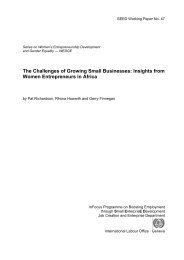manual: women workers' rights and gender equality - International ...
manual: women workers' rights and gender equality - International ...
manual: women workers' rights and gender equality - International ...
You also want an ePaper? Increase the reach of your titles
YUMPU automatically turns print PDFs into web optimized ePapers that Google loves.
• Ask them the following questions about the drawings:<br />
- What do children like most?<br />
- Are there drawings that show a violation of one of the basic child <strong>rights</strong>?<br />
- If yes, why do they think this happens?<br />
- Are there ways to solve the problems showed on the drawings?<br />
Step 3<br />
• Summarize the discussion <strong>and</strong> mention once more the <strong>rights</strong> children have.<br />
Notes for the trainer<br />
Plan the children’s session at a time that does not conflict with their school timings. If you go<br />
around when they are making the drawings, it can be helpful to make some notes of their<br />
explanations. You can use it afterwards in the session with the adults.<br />
Do not put their names on the drawings, in this way the parents do not know which drawing was<br />
made by which child <strong>and</strong> nobody has to feel uncomfortable.<br />
When the group is larger than 15 children, divide the group into two groups. Ask one group to<br />
make drawings of something they like <strong>and</strong> the other group to draw something they do not like.<br />
All human beings, adults <strong>and</strong> children alike, are entitled to human <strong>rights</strong>. But because their special<br />
needs <strong>and</strong> vulnerability, children’s <strong>rights</strong> need to be addressed with particular care <strong>and</strong> attention. A<br />
number of international instruments have been adopted to protect children’s <strong>rights</strong>. The United<br />
Nations Convention on the Right of the Child (1989) was drawn up in order to enforce <strong>and</strong><br />
safeguard children’s <strong>rights</strong>. Almost all countries in the world including Cambodia ratified this<br />
Convention. These <strong>rights</strong> include:<br />
Survival <strong>rights</strong>: All children have the right to life <strong>and</strong> to meet their most basic needs, including<br />
food, shelter <strong>and</strong> access to health care.<br />
Development <strong>rights</strong>: All children have the right to develop properly, without hindrance. They have<br />
the right to education, play, freedom of thought, religion <strong>and</strong> conscience <strong>and</strong> all other <strong>rights</strong> that<br />
will allow them to develop to their fullest potential.<br />
Protection <strong>rights</strong>: All children have the right to be protected from all forms of abuse, neglect <strong>and</strong><br />
exploitation.<br />
Participation <strong>rights</strong>: All children have the right to taken an active role in their community <strong>and</strong><br />
nation, including freedom of expression, the freedom to associate with others <strong>and</strong> to be member of<br />
a group.<br />
Education: All children have the right to receive primary school education. Secondary school<br />
education should be promoted <strong>and</strong> encouraged.<br />
Child labour: Children should be protected from exploitation <strong>and</strong> any work that endangers them in<br />
any way or stops them from getting an education. 3<br />
The Constitution of Cambodia states that the Kingdom of Cambodia shall recognize <strong>and</strong> respect<br />
human <strong>rights</strong> as stipulated in the United Nations Charter, the Universal Declaration of Human<br />
Rights, the covenants <strong>and</strong> conventions related to human <strong>rights</strong>, <strong>women</strong>’s <strong>and</strong> children’s <strong>rights</strong><br />
(article 31.1).<br />
3 Child Labour – An information Kit for Teachers, Educators <strong>and</strong> their Organizations, book 1, p.26 <strong>and</strong> 30, ILO, Geneva, 1998<br />
70

















